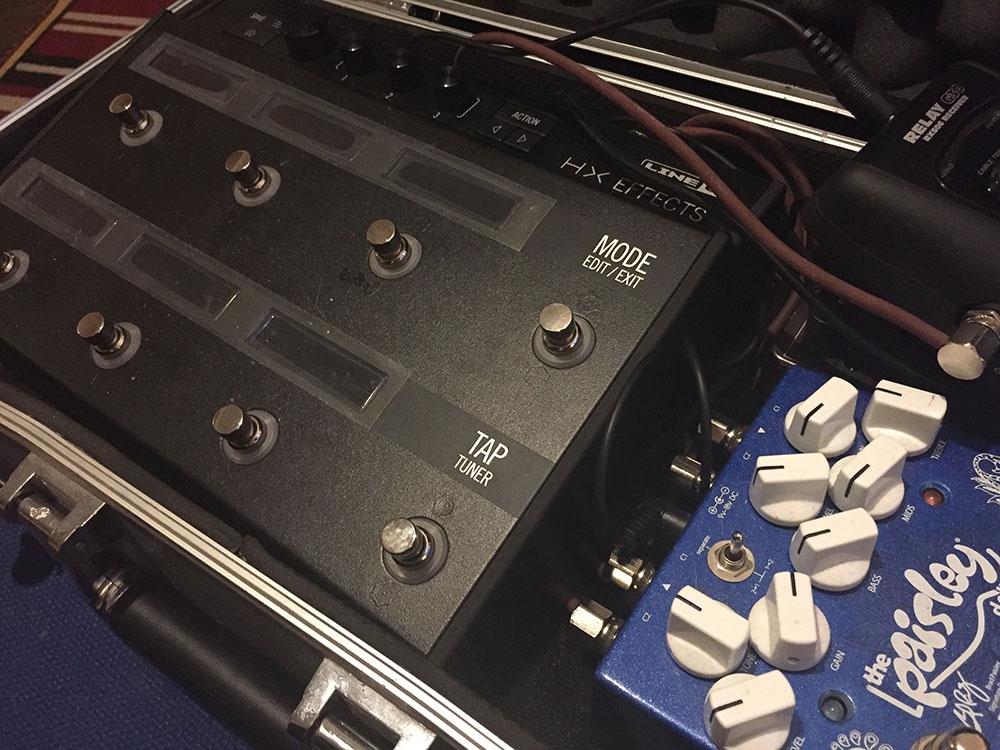
Back on October 12th I made a blog post about getting a Line6 HXFX, I gave the first impression of it and am now ready to follow up on that as I’ve finally got it out to gig over the weekend!
First of all, in regard to the purpose of the original post (I needed to downsize my rig due to an existing spinal issue), it’s job done. My 50lb pedal board is now less than a quarter of the size and weighs about a third. It’s SO good to walk into the venue with my board in one hand, my guitar on my back and my Mandolin in the other. My back and my surgeon will be forever grateful for this development!
So, what’s it all about, what’s the purpose, and why did I choose it. Regardless of all the stuff about my back, the main issue was downsizing. I play in a pub band and there isn’t room for a board that big, it just gets in the bloody way. Also, and most importantly, I love the scribble scripts. Because of that, the Helix family was the basic and most obvious choice. Couple that with the fact it’s renowned for being the easiest to use, I was a fan before I even started. However, I really must remember that what is easy for most generally means “bloody nightmare” for me as I detest reading any manual that’s over 2 pages long. I looked up the “how to use” videos and they made it so simple I thought – this is gonna be easy.
I was wrong.
First World Problems, a two-part tale of western privilege.
Firstly, there is pretty well no point in using this thing without using the HX editor from your computer. Based on space limitations, the HXFX is remarkably easy to use, but you know, it’s fiddly and annoying and you can’t use its full potential without it. This is the first major failing of it to be honest. Considering the technology out there today how on earth this was released with only a computer editor and not some kind of app, preferably with Bluetooth, is really amazing. About a year ago my big brother bought a Line6 Firehawk FX and I had a lovely time editing the sounds on it via an app on his phone as he was playing it. I’m pretty amazed that this technology hasn’t gone forward onto the HXFX. As you can imagine, editing something easily when you are on your computer at home does not translate to when you realise that one of your solo sounds isn’t quite loud enough and you need to fix it on the fly during the break… Plus, it’s 2018. I want to do it on my phone dammit.
Secondly, considering that Line6 are one of, if not THE market leader (when you take into consideration their market share) producers of high quality and small wireless systems, why wasn’t a receiver built in? I feel a trantrum coming on I WANT AN APP!!!! I WANT A RECEIVER!!!
Using it.
As with anything like this, it’s all about the mindset in how easy it is to use. I’m guessing that a lot of people will use it in stomp mode, but I’m willing to wager that there are a lot of people like me who have come from a full looper situation and are looking to condense. So, for this piece I’m going to be talking about it from that angle only. From what I can see, the vast majority of YT demos are geared towards using it in stompbox mode, so I was struggling to find the way around using it my way. Also, worth noting I’ve not properly dived into the expression pedal element of it yet.
Once I had worked out what the hell was going on, I was able to navigate the thing much easier. The first issue I had with it was the difference between patches and snapshots. They should have been called “boards” and “patches”. You see, that’s what a patch is. You set up a ‘pedal board’ within the patch and then use the snapshots to change the what is on and what isn’t. Now, this caused me no end of problems initially, but when I got my head round it, it was easy. I just then had to work out from each virtual board which patches I can use as you only get four snapshots per ‘board’ (patch). Why is this an issue you ask? Well, when you load a new ‘board’ up, the audio drops out for a split second. When you change between Snapshots, this does not happen.
The quality of the effects are generally really quite good, although with everything else that belongs in the modelling world, the whole thing is a retrospective view of the world of guitar effects. It’s crammed full of the classics, and being a tone snob within the industry who has played everything that Brian Wampler has made since 2010 and most of our competitors pedals, at times it was really disappointing. Compromises HAVE to be made when you go from a full board to one of these. This is NOT a unit for the cork sniffers who are well versed in the current trends in boutique level pedals. The compression is great if you want a vintage Ross style, or a SP Compressor, but if you are used to the Ego, or a Keeley, or an Origin Cali76, your bottom lip is going to drop when you play them. Same with the Klon model, it’s really accurate to the original, but if you’ve played any that have come after it – including the KTR – you’re going to be a fraction disappointed. The delays are great, even the tape emulator (but it ain’t no FTEv2), as are the reverbs – but at times it feels like they have made them to appeal to the guy in the store who is going to be demonstrating it so everything is kinda over the top, there is a distinct lack of subtlety within them. Unsurprisingly, the things I’ve not found a use for are the overdrives. I’m sorry Line6, but once you find the boutique level OD pedal for you, an accurate model of some of the older stuff just ain’t gonna cut it. I am an overdrive snob, which is probably why I have worked for Wampler for so long, so it was never going to work out well! Once you really get into OD’s properly, it’s not just the tone, you can actually feel the difference between all the boutique guys, Keeley’s feel different, JHS feel different… so, a digital recreation of a Boss SD-1 just isn’t going to hit the mark. Fortunately, Line6 have allowed you to have two external FX loops within so my beloved Paisley Drive Deluxe is still my main overdrive. For this run of gigs I’ve been using the Klon model in the HX, and using both side of the Paisley… however, as I only use the blue channel of the PaisleyDog as a solo boost, I am pretty certain that from here on in the Tumnus will be back on the board in the second loop and I’ll use the internal TS for boosting. Once you get used to that Tumnus feel and sound, a regular Klon model just isn’t going to cut it. I’m sorry to all you Klon purists out there, but I think it’s just better. I just wish there was a third loop so I could use the Mini Ego, but of all the compromises that I will have to make, the Tumnus and the PaisleyDog are above it on the list.
The one thing I am pretty well staggered was not included was a side chained noise gate. The effects are noisy, especially when you stack them up (in fact, the ‘same’ effects on this board has considerably more floor noise than my old board,) I’m pretty certain those big ol’ brains at Line6 could find a way of putting a noise gate in that reads when there is a signal coming from your guitar and then place the gate in a location you want (ideally, after the gain stages). All that floor noise will be gone in an instant even with the sensitivity set real low.
So, what’s the verdict then? When we look into the specifics of what I wanted, it’s doing a grand job. I wanted to replace a lot of my board and my TB looper, and it’s done this. Is it an ‘all in one’ solution for everything? Not quite – but right now, it’s probably the closest I can get to it. The key thing to remember is that almost everything you want out of a massive board is going to be compromised when you scale down.
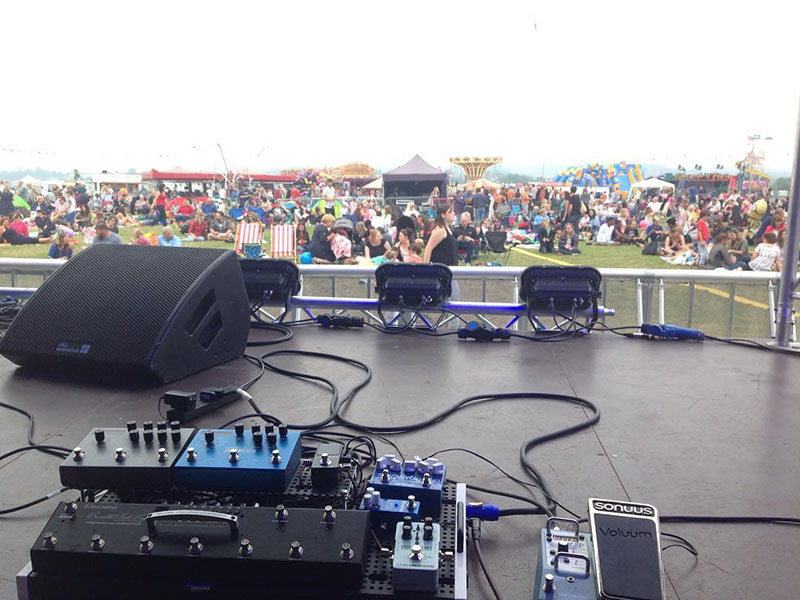
My old, big board (mostly for sale – under the Strymons are Tumnus, MiniHOF, Wireless receiver, dB+ and under the board is a Carl Martin ProPower 2. Since this was taken, the Mobius was replaced with the BOSS MD-500 and the TimeLine with a Source Audio Nemesis)…
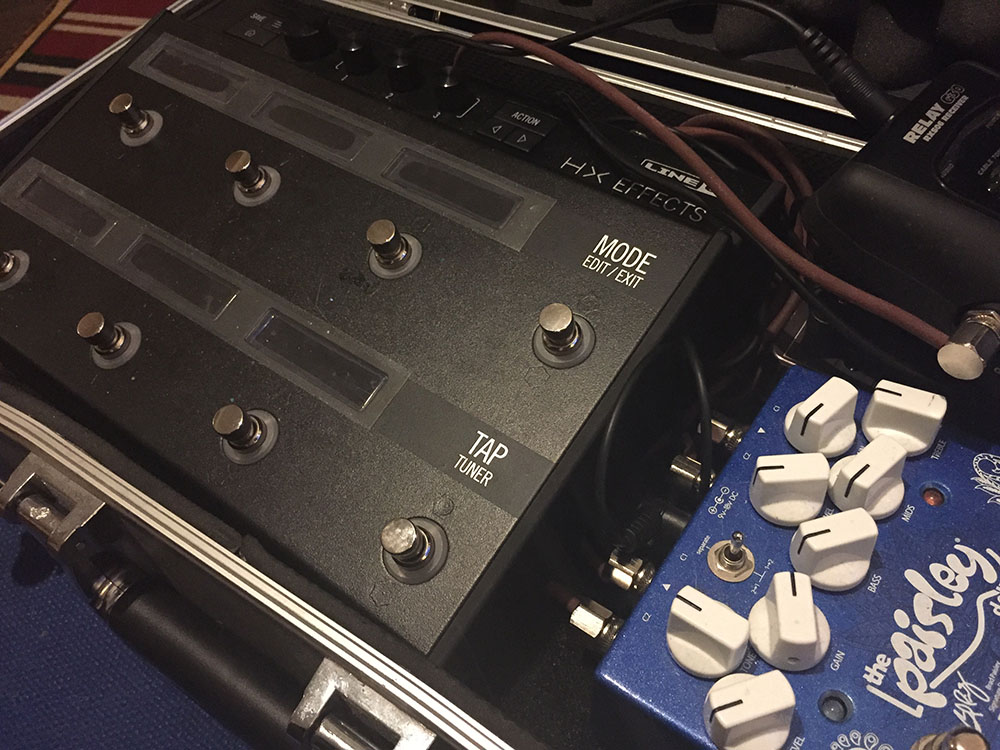
My new board, streamlined board of compromise…
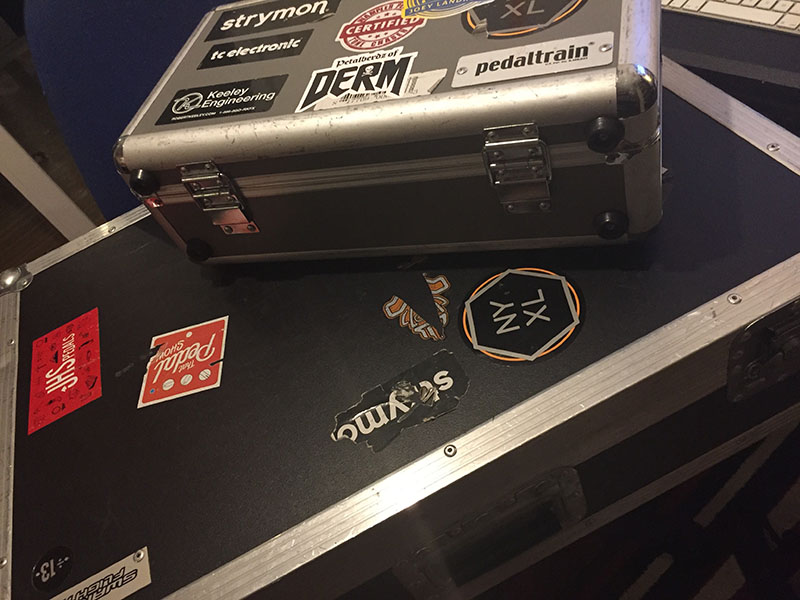
And, for a more direct comparison, here is the case for my new board sitting atop of my old one (now for sale, please contact author lololz)! The actual case for my old board weighs 2lb less than my entire new board inc case!
Pros of using something like the HXFX…
- SCRIBBLE SCRIPTS. The single most important thing on this. I can now troll myself every gig with ‘comedy’ names for my patches and snapshots. I particularly enjoy the fact I can insult our lights guy with a specific patch for his favourite part of his favourite song…. He always watches my feet as I kick that in, so the look on his face when there is an insult to him on that bit is priceless.
- The vast majority of the effects are more than good enough, in fact some of them are outstanding (“muff”, intelligent harmonizer, TS, plate reverb, Script 90 phaser and Vibe in particular)
- Ease of use. Despite what I say above, it’s easy to use, I’m just a luddite who wants everything to be so easy I don’t have to think about it.
- It is without doubt outstanding value.
and the cons…
- It draws 3A. That’s a huge power draw, hardly any supplies give that out and the wallwart is bloody huge. This will annoy me for ever!
- No app? Come on Line6, you did it with the Firehawk. Do it on the HX as well.
- On the flip side to one of the cons, some of the effects are disappointing. Most of the overdrives are dated, the gate needs updating, it needs a polyphonic pitch shifter (like the Digitech Drop), the chorus is good, but not as good as the BOSS MD-500 (better than the Mobius though)… some of them need to be calmed down (’63 Spring’ in particular).
- A built-in wireless receiver would have been perfect.
- It’s noisy. Really bloody noisy. Get a decent side chained gate in there! And get it in there now!
At home, I think it will stay in the case. I have the Full Helix for recording and quiet play, and also ‘quite’ the collection of pedals and there is nothing like grabbing a pedal off the shelf and just loving what it does. But, for live, I’m the kind of person that wants it all set up, not change and be the same gig after gig after gig. In that case, it’s perfect. If you are a ‘set and leave it’ kind of player (whether that be at home or live) then this is for you. If you are a tweaker, it just won’t work quite so well.
All in all, this has been an interesting experiment. Due to the physical limitations I have I will stick with it and enjoy every moment when I use it, because it’s good, most of my old board is now up for sale. Is it ideal? Is it perfect? Nope, gear choices rarely are – it’s all about compromises and unless you want to take a board the size of a small village out with you, it will always be this way. But… it’s good enough for a pub band and good enough for my almost exacting ears. Without the option to put my favourite OD in there it would be a massive fail, as NOTHING works for me like the PaisleyDog does, but the rest of it is close enough. I just wish I could find a way of getting my Tumnus and Mini Ego in there as well… But, I may have a plan for that. I’m getting a slightly bigger board for Christmas… so, here I go again!
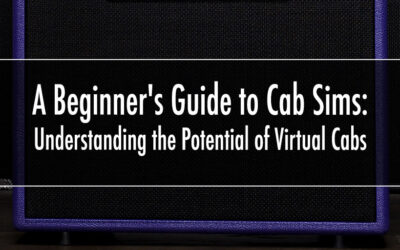
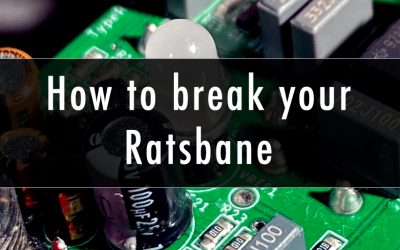
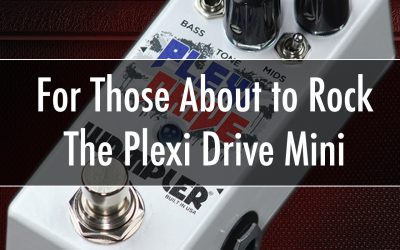
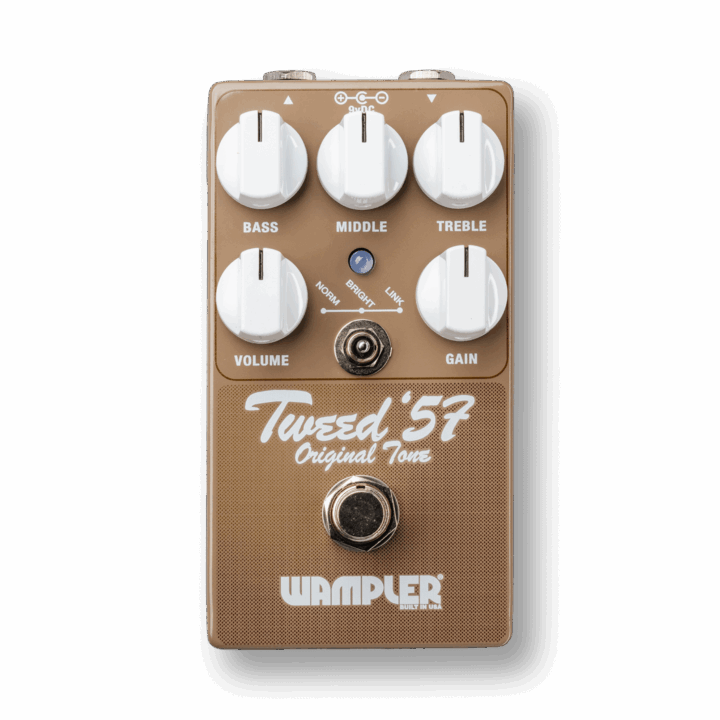
huge wampler fan, have probably 10 pedals. Wampler/boss for me. However, like you said, once you lay out your favorites without gettin too crazy, a smaller pedaltrain board is even too big. tried the nano, way too small. My hx effects fits in my backpack so to a gig, i sling the backback over my shoulder, grab my mono guitar bag and i’m gone. Hx is small and lite. perfect and for 99% of the audience, they won’t hear the difference with helix pedals and wampler. again, huge wampler fan, my favorite, i just can’t lug around all the pedals i want and need so hx perfect. tweaking a bit of a pain but way easier than my fractal ax8 that’s in the closet. sounds on fractal WAY better than helix to me but tweaking WAY more complex, takes forever. Hx so much easier. anyway, thanks for sharing cuz i feel ya, in exact same boat. have fun.
Interesting read, though a few things that maybe aren’t quite correct- there is a noise gate, using the parallel signal paths it can be effectively side chained.
The power draw isn’t 3A at all – it peaks at 1.1A on boot, and typically chugs along at about .7 – .8A. The PSU is generic to all L6 units bar the Helix/LT, so aims to cover all eventualities. After checking with Frank Richotte and Eric Klein at L6 (who are very present on the usual Gear forums and genuinely very good with questions), I run mine from two 500ma outs on the Strymon Ojai, without any issue. It’s reverse polarity though, so a bit of adapting to add to the power cable. Any good PSU should work fine! I too found the included one pretty awful.
Agree about the app, I too had the Firehawk, and while the Bluetooth and app were utterly useless live, for rehearsal and offstage editing it was absolutely brilliant. Plus it could stream from your device, great for playing along with things.
Even if BT isn’t on the HX line, an app that could be used with the camera connection kit or tethered by usb in some way would be great. I’ve used HX Edit on a Surface, but the interface isn’t great for Touch editing and ended up using a mouse, effectively making it a laptop anyway!